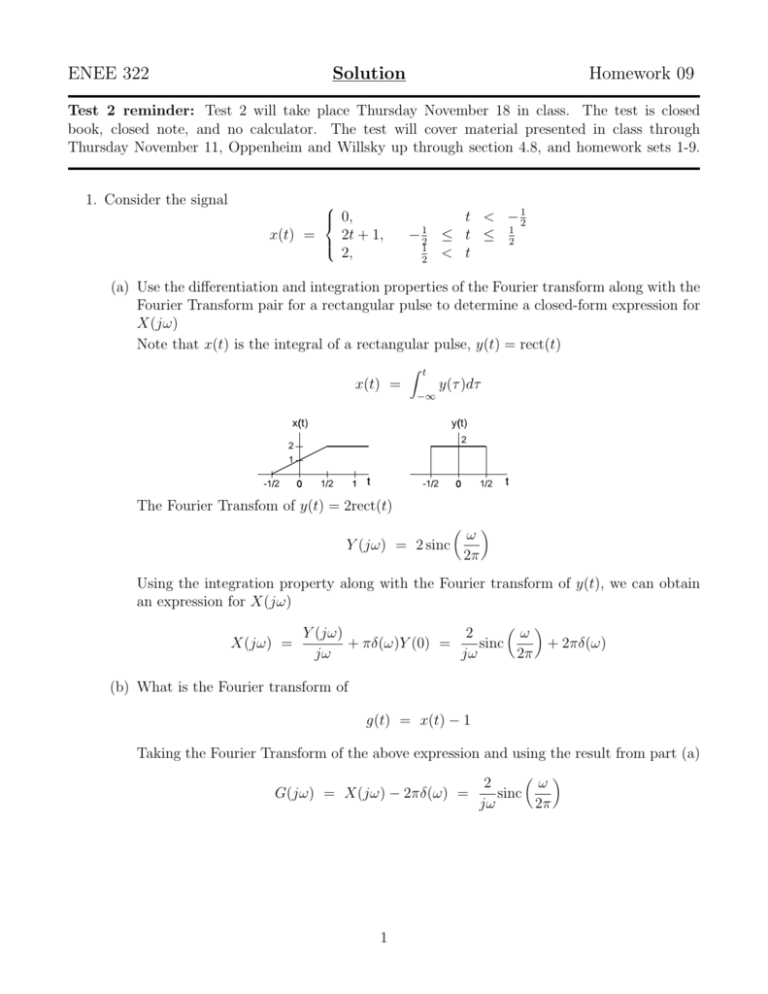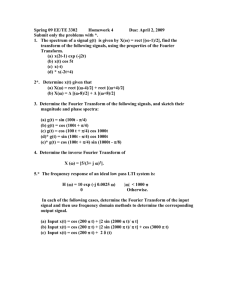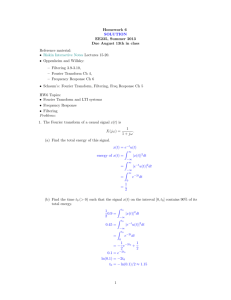ENEE 322 Homework 09 Solution: Fourier Transforms
advertisement

ENEE 322
Solution
Homework 09
Test 2 reminder: Test 2 will take place Thursday November 18 in class. The test is closed
book, closed note, and no calculator. The test will cover material presented in class through
Thursday November 11, Oppenheim and Willsky up through section 4.8, and homework sets 1-9.
1. Consider the signal
0,
x(t) = 2t + 1,
2,
t < − 12
≤ t ≤ 12
< t
− 12
1
2
(a) Use the differentiation and integration properties of the Fourier transform along with the
Fourier Transform pair for a rectangular pulse to determine a closed-form expression for
X(jω)
Note that x(t) is the integral of a rectangular pulse, y(t) = rect(t)
x(t) =
Z
t
y(τ )dτ
−∞
x(t)
y(t)
2
2
1
-1/2
0
1/2
1
t
-1/2
0
1/2
t
The Fourier Transfom of y(t) = 2rect(t)
ω
Y (jω) = 2 sinc
2π
Using the integration property along with the Fourier transform of y(t), we can obtain
an expression for X(jω)
Y (jω)
2
ω
X(jω) =
+ πδ(ω)Y (0) =
sinc
+ 2πδ(ω)
jω
jω
2π
(b) What is the Fourier transform of
g(t) = x(t) − 1
Taking the Fourier Transform of the above expression and using the result from part (a)
G(jω) = X(jω) − 2πδ(ω) =
1
2
ω
sinc
jω
2π
2. (OW 4.25) Let X(jω) denote the Fourier transform of the following signal x(t)
x(t)
2
1
-1
0
1
2
t
3
Perform the following calculations without explicitly evaluating X(jω).
(a) Find 6 X(jω)
Let y(t) = x(t + 1). Since y(t) is real and even, Y (jω) must be real and even. Now
x(t) = y(t − 1) so
−jω
X(jω) = Y (jω)e
(
X(jω) =
6
=
−ω
−ω + π
(b) Find X(j0)
X(j0) =
∞
Z
−∞
|Y (jω)| ej(−ω)
|Y (jω)| ej(−ω+π)
(
Y (jω) > 0
Y (jω) < 0
Y (jω) > 0
Y (jω) < 0
x(t)e−jωt dt
Z
=
∞
x(t)dt
−∞
ω=0
This is the area under x(t) which is the area of a rectangle (width = 4, height = 2) minus
the area of a triangle (base = 2, height −1)
X(j0) = 4 × 2 −
(c) Find
R∞
1
×2×1 = 7
2
X(jω)dω
−∞
1 Z∞
1 Z∞
jωt
x(0) =
X(jω)e dω =
X(jω)dω
2π −∞
2π −∞
t=0
Therefore
Z
∞
X(jω)dω = 2πx(0) = 4π
−∞
(d) Evaluate
Z
∞
−∞
R∞
−∞
|X(jω)|2 dω
2
|X(jω)| dω = 2π
Z
∞
−∞
2
|x(t)| dt = 4π
Z
2
2
t dt +
1
Z
3
4dt = 4π
2
h
23 −1
3
(e) Sketch the inverse Fourier Tranform of Re {X(jω)}
Recall that the even part of x(t) goes to the real part of X(jω). Hence
F −1 [Re {X(jω)}] = E V {x(t)} =
-1
1
2
{Re[X(jω)]}
2
3/2
1
1/2
-3
-2
-1
0
2
1
2
3
t
[x(t) + x(−t)]
i
+4 =
76π
3
3. (OW 4.36) Consider an LTI system whose response to the input
h
i
x(t) = e−t + e−3t u(t)
is
h
i
y(t) = 2e−t − 2e−4t u(t)
(a) Find the frequency response of the system, H(jω).
Taking Fourier transforms we have
1
1
4 + 2jω
+
=
1 + jω 3 + jω
(1 + jω)(3 + jω)
2
2
6
Y (jω) =
−
=
1 + jω 4 + jω
(1 + jω)(4 + jω)
X(jω) =
H(jω) =
=
H(jω) =
Y (jω)
X(jω)
"
6
(1 + jω)(4 + jω)
#"
(1 + jω)(3 + jω)
2(2 + jω)
#
9 + 3jω)
(4 + jω)(2 + jω)
(b) Determine the system’s impulse response, h(t).
Performing a partial fraction expansion of the answer to part (a)
H(jω) =
3/2
3/2
9 + 3jω
=
+
(4 + jω)(2 + jω)
4 + jω 2 + jω
and taking the inverse Fourier transform
h(t) =
i
3 h −2t
e + e−4t u(t)
2
(c) Find the differential equation relating the input and output of this system.
H(jω) =
h
Y (jω)
9 + 3jω
=
X(jω)
8 + 6jω + (jω)2
i
8 + 6jω + (jω)2 Y (jω) = [9 + 3jω] X(jω)
(jω)2 Y (jω) + 6jωY (jω) + 8Y (jω) = 3jωX(jω) + 9X(jω)
d2 y(t)
dy(t)
dx(t)
+6
+ 8y(t) = 3
+ 9x(t)
2
dt
dt
dt
3
4. A causal and stable LTI system has frequency response
H(jω) =
4 + jω
7 − ω 2 + 8jω
(a) Determine a differential equation relating the input, x(t), and output, y(t), of this system.
Recall that
H(jω) =
Y (jω)
X(jω)
2
Y (jω)[7 − ω + 8jω]
7Y (jω) − ω 2 Y (jω) + 8jω
d2 y(t)
dy(t)
+
8
7y(t) +
dt2
dt
(b) Determine the impulse response h(t).
Start with
H(jω) =
=
=
=
=
Y (jω)
X(jω)
4 + jω
7 − ω 2 + 8jω
X(jω)[4 + jω]
4X(jω) + jωX(jω)
dx(t)
4x(t) +
dt
4 + jω
(7 + jω)(1 + jω)
and use a partial fraction expansion to get
1
2
H(jω) =
(7 + jω)
+
1
2
(1 + jω)
and take the inverse Fourier transform to get
i
1 h −7t
e + e−t u(t)
2
h(t) =
(c) What is the output when the input is
x1 (t) = e−4t u(t)
Y1 (jω) = X1 (jω)H(jω)
"
#"
#
1
4 + jω
=
4 + jω (7 + jω)(1 + jω)
1
=
(7 + jω)(1 + jω)
Y1 (jω) =
−1
6
(7 + jω)
+
1
6
(1 + jω)
Now take the inverse Fourier transform to get
y1 (t) =
4
i
1 h −t
e − e−7t u(t)
6
(d) What is the output when the input is
h
i
x2 (t) = e−4t + te−4t u(t)
X2 (jω) = X1 (jω) +
1
(4 + jω)2
1
H(jω)
(4 + jω)2
4 + jw
1
2
(4 + jω) (7 + jw)(1 + jw)
1
(4 + jw)(7 + jw)(1 + jw)
"
#
−1
1
1
6
6
+
(4 + jw) (7 + jω) (1 + jω)
1
1
+
(4 + jw)(7 + jω) (4 + jw)(1 + jω)
1
1
1
1
− 18
− 18
18
18
+
+
+
(4 + jw) (7 + jw) (4 + jw) (1 + jw)
Y2 (jω) = X1 (jω)H(jω) +
= Y1 (jω) +
= Y1 (jω) +
= Y1 (jω) +
= Y1 (jω) +
= Y1 (jω) +
= Y1 (jω) +
=
Y2 (jω) =
−1
6
(7 + jw)
−2
9
−2
18
(4 + jw)
+
+
1
6
(1 + jw)
1
9
1
18
(7 + jw)
+
+
−2
18
(4 + jw)
−2
9
+
+
(7 + jw) (1 + jw) (4 + jw)
i
1 h −t
2e − 2e−7t − e−4t u(t)
y2 (t) =
9
5
1
18
(1 + jw)
+
1
18
(7 + jw)
+
1
18
(1 + jw)
Additional Problems. Do Not Turn In!!
5. (OW 4.31) This problem will illustrate the fact that the response to cos(t) cannot be used to
specify an LTI system uniquely.
(a) Show that the three LTI systems with impulse responses below all have the same response
to x(t) = cos(t).
h1 (t) = u(t),
h2 (t) = −2δ(t) + 5e−2t u(t),
h3 (t) = 2te−t u(t)
Taking the Fourier transforms
X(jω) = π [δ(ω − 1) + δ(ω + 1)]
1
H1 (jω) = πδ(ω) +
jω
5
H2 (jω) = −2 +
2 + jω
2
H3 (jω) =
(1 + jω)2
Passing x(t) through each system yields
h
Y1 (jω) = X(jω)H1 (jω) = π [δ(ω − 1) + δ(ω + 1)] πδ(ω) +
=
π
j
h
= π
h
−2 +
= π
h
1−j2
2+j
π
j
5
2+j
5
2−j
δ(ω + 1)
δ(ω − 1) + −2 +
δ(ω − 1) +
1+j2
2−j
π
j
5
2+jω
i
i
δ(ω + 1)
i
[δ(ω − 1) − δ(ω + 1)]
Y3 (jω) = X(jω)H3 (jω) = π [δ(ω − 1) + δ(ω + 1)]
=
i
[δ(ω − 1) − δ(ω + 1)]
Y2 (jω) = X(jω)H2 (jω) = π [δ(ω − 1) + δ(ω + 1)] −2 +
Y2 (jω) =
1
jω
h
2
(1+jω)2
i
[δ(ω − 1) − δ(ω + 1)]
Hence
y1 (t) = y2 (t) = y3 (t) = sin(t)
(b) Find the impulse response of another LTI system with the same response to cos(t).
h4 (t) =
1
3
[h1 (t) + h2 (t) + h3 (t)]
6
6. (OW 4.32) Consider an LTI system with impulse response
sin [4(t − 1)]
π(t − 1)
h(t) =
Determine the system output for each of the following inputs:
Note that h(t) = g(t − 1) with
g(t) =
sin(4t)
4 sin(4t)
=
πt
π 4t
−jω
H(jω) = G(jω)e
(a) x1 (t) = cos 6t +
π
2
ω −jω
= rect
e
=
8
(
e−jω
0
|ω| < 4
|ω| > 4
Taking the Fourier transform,
x1 (t) =
1 j(6t+π/2)
e
2
j π2
+ 12 e−j(6t+π/2) =
1 j π2 j6t
e e
2
π
+ 12 e−j 2 e−j6t
π
X1 (jω) = πe δ(ω − 6) + πe−j 2 δ(ω + 6)
we see that X1 (jω) is zero in the passband of H(jω), so
Y1 (jω) = X1 (jω)H(jω) = 0 =⇒ y1 (t) = 0
(b) x2 (t) =
∞ X
k
1
2
sin (3kt) Taking the Fourier transform,
k=0
X2 (jω) =
∞ X
k π
1
2
j
k=0
[δ(ω − 3k) − δ(ω + 3k)]
we see that only the k = 0 and k = 1 terms are in the passband of H(jω), so
Y2 (jω) = X2 (jω)H(jω) =
y(t) =
π
[δ(ω − 3) − δ(ω + 3)] e−jω
j2
1
sin[3(t − 1)]
2
sin [4(t + 1)]
π(t + 1)
Since x3 (t) = g(t + 1), we have
(c) x3 (t) =
ω +jω
X3 (jω) = G(jω)e = rect
e
8
ω +jω
ω −jω
ω
Y3 (jω) = X3 (jω)H(jω) = rect
e
rect
e
= rect
8
8
8
sin(4t)
y3 (t) =
πt
jω
7











